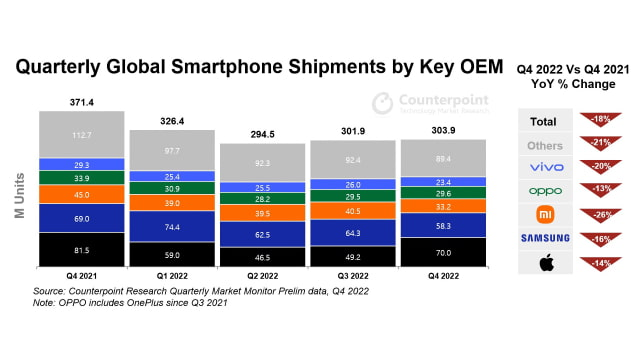Apple smartphone profits have become a focal point in the tech industry, capturing an astonishing 94% of total profits in Q3 2015 despite holding a mere 13.4% of global smartphone shipments. This impressive financial performance highlights the company’s dominance in the premium segment, where brand loyalty drives consumers to invest in its high-priced devices, notably the iPhone. The smartphone market competition has intensified, yet Apple continues to thrive amid challenges posed by emerging brands like Xiaomi and Huawei, which offer lower-cost alternatives but lack significant profit margins. With historical iPhone profits in 2015 showcasing Apple’s incredible ability to monetize its products, the landscape of smartphone sales analysis reveals an interesting dichotomy between high-end and budget offerings. Meanwhile, Samsung’s profit share in 2015 struggled to keep pace, garnering only 11%, further solidifying Apple’s position as the leader in the mobile market.
In examining the financial success of Apple within the mobile device sector, it’s evident that the company’s smartphone revenues soar above competitors. Apple’s remarkable ability to capture nearly all profits in the premium smartphone market, juxtaposed with its modest market share, echoes broader trends in mobile ecosystem dynamics. As other manufacturers like Samsung and various Chinese brands grapple to secure their positions, Apple’s consistent performance speaks volumes about consumer preferences for higher-quality devices. The contrasting strategies among manufacturers reveal a landscape where profit margins and brand loyalty heavily influence sales outcomes. Ultimately, the competition between Apple’s iPhone and Google’s Android devices continues to shape the future of mobile technology and market profitability.
Apple Smartphone Profits: An Unmatched Dominance
In the smartphone industry, Apple has consistently demonstrated its ability to generate immense profits, notably capturing a staggering 94% of total profits for Q3 2015, despite its relatively modest market share of just 13.4%. This exceptional profit margin can be attributed to Apple’s premium pricing strategy and loyal customer base, who value brand reputation and innovation over cost. Such figures underscore Apple’s dominance in economic performance within the competitive landscape of mobile devices, where they outshine competitors like Samsung, which managed only 11% of profits for the same period.
The high profitability of Apple’s smartphones can be further understood in the context of smartphone sales analysis, particularly from the perspective of consumer behavior. While many brands have released low-cost alternatives, such as those from Xiaomi and Huawei, these products often have lower profit margins. Apple’s sustained profitability in the face of growing competition underlines the brand’s ability to maintain its high pricing strategy while still expanding its user base and solidifying its market presence.
Frequently Asked Questions
What percentage of the smartphone market profits did Apple capture in Q3 2015?
In Q3 2015, Apple captured an impressive 94% of the total smartphone market profits, despite holding only a 13.5% share of the total smartphones shipped worldwide.
How does Apple’s smartphone market share compare to Samsung’s profit share in 2015?
While Apple held a 13.5% market share and secured 94% of the profits in Q3 2015, Samsung managed to capture only 11% of the total profits, highlighting the competitive disparity in mobile market competition.
What factors contribute to Apple’s high iPhone profits despite low market share?
Apple’s high iPhone profits, despite a relatively low market share, can be attributed to its premium pricing strategy and brand loyalty, which encourages customers to invest in higher-priced devices rather than opting for lower-cost alternatives.
Why are low-cost Android brands like Xiaomi not significantly affecting Apple’s smartphone profits?
Brands like Xiaomi and Huawei, which flooded the market with low-cost devices, tend to operate on low-profit margins, which means they do not significantly impact Apple’s overall smartphone profits.
What challenges does Apple face from competitors in the smartphone market?
Apple faces challenges from competitors like Samsung and emerging brands, especially in mobile market competition, where companies like Huawei are gaining market share. However, Apple’s strong brand loyalty and high-profit margins help it maintain a competitive edge.
What implications do the Q3 2015 profit figures have for future smartphone sales analysis?
The Q3 2015 profit figures suggest that while Apple dominates in terms of profits, overall smartphone sales may reflect broader dynamics, including increased competition from Chinese OEMs that focus on volume sales rather than high profits.
How has the landscape of smartphone profits shifted since 2015?
Since 2015, the smartphone profits landscape has continued to evolve with increased competition from companies like Xiaomi and Huawei, but Apple remains a dominant player with substantial profits from its iPhone sales, illustrating the enduring strength of its brand.
What insights do expert analyses provide regarding Apple’s iPhone profits?
Expert analyses, such as those from Canaccord Genuity, highlight that despite the increase in low-cost smartphone options, Apple’s iPhone remains highly profitable due to its premium market positioning and loyal customer base.
| Key Point | Details |
|---|---|
| Apple’s Profit Share | Apple captured 94% of total smartphone profits in Q3 2015. |
| Market Share | Despite holding only a 13.5% share of global smartphone shipments. |
| Competitors’ Profitability | Samsung managed only 11% of profits; Xiaomi and Huawei have low profit margins. |
| Long-standing Market Presence | Apple has been a key player in the smartphone market since 2007. |
| Consumer Loyalty | Apple enjoys a strong loyalty from customers, waiting in long lines for new releases. |
| Market Dynamics | Conflict between Apple’s iPhone and Android ecosystem is evident. |
Summary
Apple smartphone profits are among the highest in the industry, demonstrating the company’s ability to dominate the market even with a relatively small share of total smartphone shipments. In Q3 2015, Apple secured an impressive 94% of profits from the smartphone segment, confirming its premium pricing strategy and the fierce brand loyalty of its customers. This remarkable achievement reflects not just Apple’s innovation and brand strength but also highlights the competitive landscape challenged by low-cost alternatives from companies like Xiaomi and Huawei. While they dominate in unit sales, their profit margins remain low, leaving Apple in a prestigious position within the industry.








